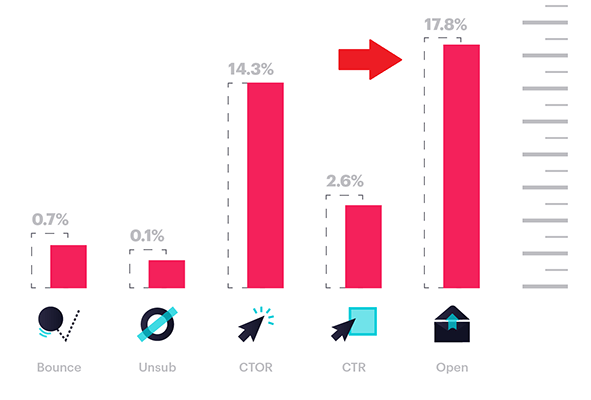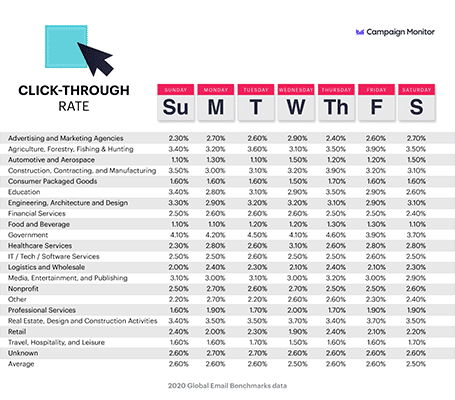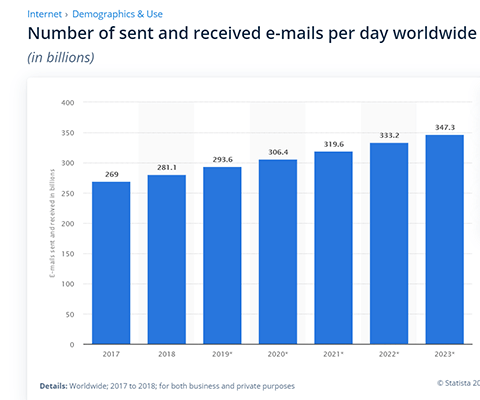Email marketing is the highest-achieving go-to ecommerce marketing solution, and as relevant to marketing goals as it ever was – below are the statistics to prove it. Be warned though, there is one section within it, called hyper-personalised product selection, that takes it and blows the ROI out of the water, but we’ll come to that later.
We’ve put together 40+ email marketing statistics that show you the state of email right now. It is still the most effective marketing channel available to ecommerce marketers and highlights important trends that you need to know.
The insights you can extract from the data below will tell more about how email marketing is changing, and how your strategy needs to change with it.
Email marketing statistics & benchmarks
Let’s start by looking at the latest industry benchmarks uncovered in a recent email marketing report. These benchmarks are useful for measuring your performance.
The average email open rate is 17.8%
That’s the average open rate across all industries and is based on data gathered from over 30 billion emails sent throughout a single year. How do your stats compare?

Retail only has a 13.9% average open rate
Interestingly, retail also sits at the bottom end of the table, dropping from an average open rate of 15.2% to 13.9% this year. This represents the high level of competition in the ecommerce and retail space, which impacts email open rates.
It’s not all bad news though – retail businesses also generate high email engagement and excel at driving consumer action.
This makes a strong argument for focusing more on CRO and personalisation of high-converted product selections in your email if you’re a retailer to make the most of the customers that do open your emails.
The average email click-through rate is 2.65%
Again, that’s the average across industries and Government agencies were the top performers, with a 4.1% average CTR.

Both bounce (0.7%) and unsubscribe rates (0.1%) are on the rise
Average bounce rates (the percentage of recipients who don’t receive your email) and unsubscribe (the percentage of a mailing list that unsubscribe from communications) both improved compared to last year.
This shows us that marketers are getting better at keeping their lists clean and improving deliverability.
Tuesdays have the highest open (18.3%) AND unsubscribe (0.2%) rates
Take this statistic with a pinch of salt though, as the differences are minimal and almost insignificant. Don’t get too hung up on chasing the ‘best day’ and focus on creating effective email campaigns.
Importance/relevance of email content
Below are some more email marketing statistics that highlight just how important email still is to marketers and businesses, and why.
Around 80% of SMBs say email is their most important customer acquisition/retention channel
Interestingly, significantly more SMB marketers voted for email than organic search, paid search, and social media. When it comes to acquiring new customers and retaining them, it looks like nothing beats email. (eMarketer)
Email is 40x more effective than social media for customer acquisition
That’s right, email is 40 times as effective as both Twitter and Facebook combined at acquiring new customers. (McKinsey)
U.S. companies spent an estimated $3.07 billion on email marketing in 2019
This is according to estimates from Statista. If accurate, that means companies increased their spending on email marketing by around a third in just 5 years. (Statista)
Email traffic converts better than both social and search traffic
4.24% of email traffic leads to purchases, whereas only 2.49% of search traffic and 0.59% of social traffic do the same. This makes sense as email subscribers are usually much further down the sales funnel and are more likely to have been through a lead nurturing process. (The American Genius)
93% of marketers say email is their top content distribution channel
This is according to a 2017 report from the Content Marketing Institute. The second most popular channel used to distribute content was LinkedIn. (Content Marketing Institute)
Email usage statistics
With the rise of social media and messenger apps, you’d be forgiven for assuming that email is on its way out – but that’s not necessarily the case. As the statistics below show, overall email usage is still high.
347 billion emails will be sent every day by 2023
This estimate marks a dramatic increase from the 281 billion emails that were sent back in 2018. The figure has been growing year on year and reflects the growth in the number of global email users. (Statista)

More than 50% of the global population uses email
Speaking of the growth in the number of global email users, around half of the world’s population now use email. By 2023, there will be 4.4 billion email users. (Statista)
99% of consumers check their email once or more every single day
And that’s just their email accounts. If we factor in work and mobile inboxes, the average is around 20 times per day. (DMA Insights)
Consumers have 2-3 email accounts
But they don’t use them all in the same way. They’re much more likely to sign up for mailing lists on their account than their work account, and 44% of them have an email address set up exclusively for marketing messages. (DMA Insights)
Email is the preferred way to receive brand updates
By a large margin. 66% of consumers rank email as their preferred brand communication channel, compared to just 23% that prefer social media.
Email marketing ROI statistics
Let’s talk money. Here are some statistics that tell you more about the ROI of email marketing campaigns.
Email marketing has an average ROI of 42:1
This suggests that for every dollar you spend on your email marketing efforts, you can expect to earn $42 back, on average. Average ROIs are also up from last year when the ratio was 38:1. (Litmus)
66.3% of participants in a marketing survey say email ROIs will increase
Even though email marketing ROIs are already higher than any other marketing channel, marketers are optimistic that it will continue to climb even higher. The majority of marketers also agree that it will continue to be one of the top channels in delivering ROI for at least the next 5 years.
Brands still struggle to effectively measure email ROI
Only around 30% of brands think they can measure their email marketing ROIs well. Around 32% can measure it adequately, and around 38% poorly or very poorly. This may be because most brands haven’t yet developed and executed sophisticated email marketing programs, or a sign that brands don’t consider measuring email ROIs to be a top priority due to the well-known high-ROIs.
The most sophisticated email marketing programs generate lower ROIs
Counter-intuitively, making your email marketing programs more sophisticated may actually lower your immediate ROIs. Unsophisticated programs generate ROIs of 44:1 compared to sophisticated program ROIs of just 38:1. This may be because more sophisticated programs shift their focus from immediate return rates to overall returns.
Email open rate statistics
The open rate is the percentage of email recipients that open your emails; it’s an important metric when it comes to evaluating the performance of your email marketing campaigns. Here are a few open rate statistics you might find interesting.
Welcome emails have the highest open rates
Average welcome email open rates stand at a whopping 82% because customers are expecting them, and looking out for them to land in their inbox. Make sure you’re taking advantage of that high open rate. Hardly surprising as it is both new and an endorsement of that individual’s personal preference to subscribe, for which everyone looks for validation. (GetResponse)
Email spam rate stats
Spam rates are important too – nobody wants their valuable marketing communications to end up lost in their customer’s spam box. Below are some email spam rate stats that you might find useful.
45% of all emails are considered spam
A whopping 14.5 billion spam emails are sent every single day, so it’s no wonder consumers are wary of them. Make sure you’re not part of the problem and only send promotional messages your customers want to hear. (Blogging Wizard)
69% of email recipients mark emails as spam based on the subject line
This is why subject lines are so important, not just for your open rates, but for deliverability too. (OptinMonster)
43% of email recipients mark emails as spam based on the sender’s email address
Yep, email addresses are important too. This shouldn’t be a problem if you’re using a legitimate business email address. (Vivipins)
Mobile email statistics
Here are email marketing statistics that relate to mobile use.
62.13% of people will ignore or delete an email that doesn’t look or work as expected on their mobile
The same study of 1,424 adults revealed that 20.87% would try their best to read the email and 17% would look at it later on their desktop/laptop. (Dyspatch)
49% of emails are opened on mobile
If you’re not optimizing your email messages for mobile users, you’re not optimizing your emails for almost half your list. (IBM)
81% of people check emails on smartphones compared to just 21% on tablets
Of all those mobile users, around four-fifths open emails on their smartphones. Again, this shows how important it is to optimize your emails for small screens. (Adobe)
People in the UK are more likely to read emails on their mobile compared to other countries
If your customers are primarily from the UK, it’s even more important to focus on mobile. 62.9% of UK consumers read emails on their mobile phones. (IBM)
Older generations are much less likely to read an email on their mobile-first
55% of 56 to 67-year-olds say they aren’t likely to read emails on their mobile first, whereas just 18% of 19 to 34-year-olds say the same. (Adestra)
Email hyper-personalisation statistics
These email hyper-personalisation stats help corroborate its value. No matter how you slice it, personalisation is helping boost the success of email marketing strategies across a wide array of industries.
66% of marketers are working toward securing internal resources to execute personalised marketing programs. – Conversant Media
When asked to prioritize one capability that will be most important to marketing in the future, 33% of marketers answered: “personalisation.” – Adage
74% of marketers say targeted personalisation increases customer engagement. – SEO Site Checkup
Only 39% of online retailers send personalised product recommendations via email. – Certona
Emails with personalised subject lines are 26% more likely to be opened. – Campaign Monitor
Personalised emails deliver 6x higher transaction rates. – Experian
53% of marketers say ongoing, personalised communication with existing customers results in moderate to significant revenue impact. – DemandGen
94% of customer insights and marketing professionals across multiple industries said personalisation is “important,” “very important,” or “extremely important” for meeting their current email marketing objectives. – Conversant Media
Marketers see an average increase of 20% in sales when using personalised experiences. – Monetate
50% of companies feel they can increase interaction within email by increasing hyper-personalisation. – Experian
Some brands have recorded 8x improvement in click-through rates with a personalised video versus standard outbound email campaigns. – Marketing Land
The open rate for emails with a personalised message was 18.8%, as compared to 13.1% without any personalisation in 2016. – Statista
Hyper-personalisation software – personal product content selection for email marketing
Hyper-personalisation software is the most lucrative way of eliminating most (if not all) of the traditional customer’s buying decision-making process. Simply put, they have already told you, be it not in so many words. You’re just using that information (data) to the greatest effect.
Consider for a moment if you knew what each consumer you have, was most likely to buy next. Firstly you’d save a fortune on marketing, as you can just highlight that individual product they wanted. Then you wouldn’t have it sent back if it didn’t suit, as you already know it will.
From the customer’s perspective, you have begun to appreciate them as an individual – rather than a segment of people, who always buy an item in a certain way, perhaps a certain brand, colour, material, label etc each season. Instead, you appear to appreciate what it is they want, while you have been watching what they have been looking at.
Think about it as the assistant in a shop. They don’t suddenly rush up to a customer wearing boots to offer them a discounted pair, while they’re looking at coats. It would be incongruous.
Predictive personalisation software – the consumer’s reaction in practice
It’s unfair to compare really, but the truth is that it blows traditional expectations out the window. Leading research industry pillars McKinsey, Bain, Forrester and Statista all agree, that it delivers 20x the return of traditional marketing, social media and omni-channel marketing combined. Not 20% more – 20x more.
PPS addresses consumers who don’t send products back, and the fashion industry especially will appreciate that, as all the additional costs and headaches associated almost disappear. Another phenomenon is that the average basket size increases, by about 15% initially and even better it perpetually grows over time.
This in turn raises the customer lifetime value of each consumer. With all this additional business comes the further benefit that PPS runs autonomously, you simply don’t involve human beings in the process. It’s data-driven, and humans have too many foibles denigrating the effect. How much does your staff cost? No holidays, loo breaks, training, car parking, school runs, water cooler moments – anything, just pure unadulterated focus.
How does predictive personalisation software work?
PPS sequences data live, first all the previous buying history to learn and appreciate each consumer you have, and then impressions as each of those individuals come to your site or email, to learn and appreciate every nuance and subtlety about them. How often they visit a product before buying, how long they took at that item, how that relates to previous buying decisions, what specifically do they enjoy most etc, all this information accrues. This is not as a collective, but each one individually.
PPS selects products unique and specific to each individual, based on their data. It then selects and sends perfectly chosen products – to the nano-second, before it does so. These are products identified as the most likely to be bought next. It excludes promotions, incentives and annoying banners, but complements those promotions if you are running them. It caters for price points too.
You don’t have to worry about landing pages, as each product is linked to the specific product, ready to simply click to add it to their basket. Cutting out superfluous elements that while they look good, or fit in with the pleasantries of a campaign being run, cause distraction and lack of singular attention to the purpose at hand.
Further, that it is delivered to your consumer’s inbox negates such rigorous comparison on each product’s price too. An email doesn’t have anything for the consumer to compare it with, and it also benefits from a previously established “given” that you are always there or thereabouts on price, quality, delivery etc, having won their trust previously as their preferred supplier.
Index to all our articles and perpetuate your ecommerce growth, click here.
SwiftERM is a Microsoft Partner company. For a month-free 30-day trial of AI hyper-personalisation software click here.





